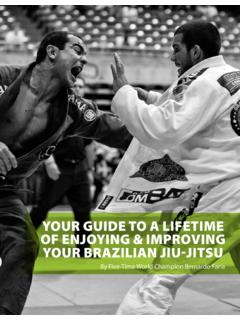Transcription of Getting Started in Brazilian Jiu-Jitsu - CrossFit
1 CrossFit is a registered trademark of CrossFit , Inc. 2008 All rights info at to Journal Article Reprint. First Published in CrossFit Journal Issue 67 - March 2008 Getting Started in Brazilian Jiu-JitsuBecca Borawski1 of 4 One of the most frequent topics of conversation I seem to engage in with fellow CrossFitters is about Getting Started in Brazilian jiujitsu. People want to know what to expect, how to prepare, how to combine it with their strength and conditioning training, and how to get better. To help answer these questions, I interviewed a panel of successful Jiu-Jitsu players to find out their take on how to start, survive, and succeed at Brazilian Jiu-Jitsu . This first article in the series focuses on how to choose a school and panel of expertsJimmy Tang has been training in Brazilian Jiu-Jitsu , both with and without the traditional gi, for six and a half years.
2 A frequent tournament competitor, Jimmy earned his brown belt from Jean Jacques Machado in Florian is a mixed martial arts (MMA) fighter, Ultimate Fighter contestant, and top contender in the 155-pound weight division in the UFC. He has been training Brazilian Jiu-Jitsu for approximately eleven years and earned his black belt, in five and a half years, from Roberta Maia of Gracie Worthington has been training for nine years. She earned her purple belt from Carlson Gracie and Carlson Gracie, Jr. Currently she trains under Johnny Ramirez and John Ouano at New Breed Academy (and she CrossFits at Petranek Fitness/ CrossFit Los Angeles). In 2007 Valerie won the gold in her weight division at the World Grappling Games in Antalya, Fletcher trains MMA with Greg Jackson in New Mexico and is a veteran of the Ultimate Fighter television show.
3 He has been training for approximately eight years, earning his brown belt from Eddie Bravo. Valerie Worthington (left) at the World Team Trials, July 2007. CrossFit is a registered trademark of CrossFit , Inc. 2008 All rights info at to of 4 Getting Started in Brazilian Jiu-Jitsu ( )How to choose a schoolA lot of different factors go into choosing a school to begin your training. It is a good idea to visit multiple schools before committing to one. Think about the atmosphere, the experience of the instructor, and the composition of the student body. Do not underestimate the importance of the attitude and energy. Says Valerie, If there are multiple schools in your area, absolutely try as many on for size as you can. If you end up becoming remotely serious about BJJ, you will be spending a lot of time at the academy you choose, so you want to make sure it is a place that inspires and energizes you.
4 The head of the school sets the tone for the school, and it is important that the attitude and atmosphere are one you are comfortable with. Instructors usually draw people similar to themselves, says Tait. If the instructor is level headed and friendly most of the students will follow suit. It may even take multiple visits to a school to ascertain the true feel of the place. If the school is amenable, take advantage of that opportunity. What you observe in one visit may not represent the school or instruction completely, states Tait. Ask questions of yourself like How helpful are the students? Does the named instructor really teach the classes? and go back a few times to verify whatever your conclusions are. One of the first things people look at when choosing a school is the head instructor.
5 A common misconception is that an instructor must have been a successful competitor in order to be a good teacher. Says Jimmy, It s nice to say your instructor is a World Champion, but it s better to say your instructor has made world champions. Kenny Florian agrees, Not every great teacher was a BJJ world champion. Valerie breaks it down even further, noting three elements you should look for in an instructor: 1) a high belt rank that can be traced back to a Gracie or Machado, 2) ample competition experience, and 3) a real understanding of how to teach BJJ. If you can t find someone who has it all, she says, consider which elements are most important to you. If you are a rank beginner, it might be better to find someone who is considered a good teacher, even if his competition record is limited or he is only a purple or brown belt.
6 If you are a higher rank and want to improve your own competition record, consider going with someone whose teaching skills are not necessarily noteworthy but who has a reputation for preparing students well for competition. Jimmy Tang goes for a takedown at the American National Championships in September Tang at the No-Gi Mundials, December 2007. CrossFit is a registered trademark of CrossFit , Inc. 2008 All rights info at to of 4 Getting Started in Brazilian Jiu-Jitsu ( )Related to this is how the classes incorporate sparring. If competition is an important aspect of Brazilian Jiu-Jitsu for you, then you should also make sure there is a sparring emphasis at the schools you are researching. Says Jimmy, Some schools give more sparring time than others. If you think you like to spar more then just going over techniques, some schools may be more geared for you then others.
7 Another factor to consider is the other students with whom you will be training and sparring. A broad spectrum of belt ranks is the preferable atmosphere. You need the whole spectrum to help improve quickly, says Jimmy. People who aren t as skilled as you allow you to work on new things. People close to or equal to your skills let you go all out. People who are significantly more skilled then you force you to learn how to stay calm and practice defense. Adds Valerie, Training with upper belts can help you improve your game faster than training with white belts because the upper belts can give you constructive feedback the way the instructor would. Because Brazilian Jiu-Jitsu is a match between two individuals and is broken down by weight class in competition, it is important to consider not only the experience level of the students but also the physical make-up of the population.
8 My personal belief, says Valerie, is that I can learn something from rolling with anyone, regardless of rank or size. If I m rolling with someone smaller or less experienced, I can work on attacks or defenses I m trying to work into my game. If I m rolling with someone bigger or more experienced, I may not have a choice about what I m working on! However, size differences among students, and instructors, can be both an asset and a potential problem. As Jimmy explains, Some instructors teach a lot of guard because they are small. If you re a large person you might want to take that into consideration. The instructor might not be able to really give you insight on being a big person trying to play the top game. On the other hand, the struggle of being a smaller person in a sea of large teammates can be stressful, but possibly stimulating.
9 Says Tait, In my experience, smaller people who are tenacious get better quicker. They must. The pressure of fighting against bigger, stronger opponents gives a quick learning curve. Ultimately, like belt rank, the best teammate situation would include a wide range of body , while Brazilian Jiu-Jitsu is not as popular with women as it is with men, having female teammates to train with can be a valuable asset. Jimmy explains, Smaller people and female students help larger men practice self control and finesse. You don t need to out power a smaller or female opponent. Being a woman training Brazilian Jiu-Jitsu comes with its own set of challenges. Says Tait, There will be guys in class that will take you under their wing, and some will fear you and consequently be rough with you in an effort to not get dominated by a woman.
10 You will also know, after a few times of training with everyone, who you want to train with and who you don t. Your instructor must be helpful with navigating these waters. Valerie also encourages people to talk with their instructor about the expectations at the academy. Some men may prefer not to roll with women at all, while others may be very helpful. It is important early on to establish communication and understanding with your teacher to help create a safe and productive training thing about martial arts schools some people balk at is the requirement to sign a contract and commit to being a member for a period of time. In regards to this, Kenny asks, Do you want to learn a little or a lot? You should expect to dedicate yourself for at least a year to two years before you give up on it. Mastery takes a lifetime.










